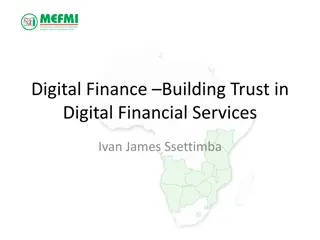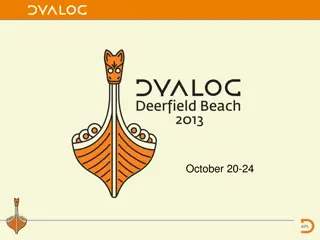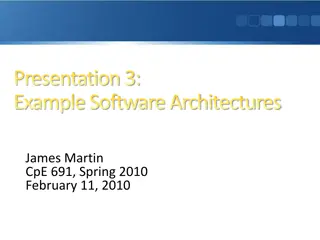Understanding Graph Modeling and DFS Applications
Explore the world of graph modeling and DFS applications through lectures on graph vocabulary, edge classification in directed graphs, and the use of DFS to find cycles. Discover the significance of tree edges, back edges, forward edges, and cross edges in graph traversal. Learn how DFS can be utilized to identify cycles in a directed graph, and delve into the concept of back edge characterization.
Download Presentation

Please find below an Image/Link to download the presentation.
The content on the website is provided AS IS for your information and personal use only. It may not be sold, licensed, or shared on other websites without obtaining consent from the author. Download presentation by click this link. If you encounter any issues during the download, it is possible that the publisher has removed the file from their server.
E N D
Presentation Transcript
Graph Modeling CSE 421 22AU Lecture 5
Announcements HW2 went out Wednesday night Wednesdays will be our regular HW due/release date. On the webpage, you can find: A list of algorithms/data structures from 332 Homework formatting advice and a style guide With high probability, your pseudocode is (if anything) too detailed.
A More Graph Vocabulary C B A cycle is a path, with an extra edge from the last vertex back to the first vertex. D F E A directed acyclic graph (DAG) is a directed graph that has no cycles. C B D F E
Today Use DFS to find cycles More DFS applications (review from 373) Graph practice
The orange edges (the ones where we discovered a new vertex) form a tree!* We call them tree edges. 1 12 2 11 That blue edge went from a descendent to an ancestor B was still on the stack when we found (B,D). We call them back edges. 3 6 The green edge went from an ancestor to a descendant F was put on and come off the stack between putting A on the stack and finding (A,F) We call them forward edges. The purple edge went some other way. D had been on and come off the stack before we found F or (F,D) We call those cross edges. 4 5 7 10 *Conditions apply. Sometimes the graph is a forest. But we call them tree edges no matter what. 8 9
Edge Classification (for DFS on directed graphs) Edge type Definition When is (?,?) that edge type? Tree Edges forming the DFS tree (or forest). ? was not seen before we processed ?,? . ? and ? have been seen, and u.start < v.start < v.end < u.end ? and ? have been seen, and v.start < u.start < u.end < v.end Forward From ancestor to descendant in tree. Back From descendant to ancestor in tree. Cross Edges going between vertices without an ancestor relationship. ? and ? have been seen, and v.start < v.end < u.start < u.end The third column doesn t look like it encompasses all possibilities. It does the fact that we re using a stack limits the possibilities: e.g. u.start < v.start < u.end < v.end is impossible. And the rules of the algorithm eliminate some other possibilities.
Actually Using DFS Here s a claim that will let us use DFS for something! Back Edge Characterization DFS run on a directed graph has a back edge if and only if it has a cycle. A cycle is a path, with an extra edge from the last vertex back to the first vertex.
Forward Direction If DFS on a graph has a back edge then it has a cycle. Suppose the back edge is (?,?). A back edge is going from a descendant to an ancestor. So we can go from ? back to ? on the tree edges. That sounds like a cycle!
The Backward Direction We might not just walk along the cycle in order. Are we going to visit ?? in time or might ??,?0 be a cross edge? DFS discovery DFS(v) finds exactly the (unseen) vertices reachable from ?.
The Backward Direction We might not just walk along the cycle in order. Are we going to visit ?? in time or might ??,?0 be a cross edge? Suppose G has a cycle ?0,?1, ,??. Without loss of generality, let ?0 be the first node on the cycle DFS marks as seen. ?? is reachable from ?0 so we must reach ?? before ?0 comes off the stack. When we get to ??, it has an edge to ?0 but ?0 is seen, so it must be a back edge.
Summary DFS discovery DFS(v) finds exactly the (unseen) vertices reachable from ?. Back Edge Characterization A directed graph has a back edge if and only if it has a cycle.
Edge Classification (for DFS on directed graphs) Edge type Definition When is (?,?) that edge type? Tree Edges forming the DFS tree (or forest). ? was not seen before we processed ?,? . ? and ? have been seen, and u.start < v.start < v.end < u.end ? and ? have been seen, and v.start < u.start < u.end < v.end Forward From ancestor to descendant in tree. Back From descendant to ancestor in tree. Cross Edges going between vertices without an ancestor relationship. ? and ? have been seen, and v.start < v.end < u.start < u.end The third column doesn t look like it encompasses all possibilities. It does the fact that we re using a stack limits the possibilities: e.g. u.start < v.start < u.end < v.end is impossible. And the rules of the algorithm eliminate some other possibilities.
BFS/DFS caveats and cautions Edge classifications are different for directed graphs and undirected graphs. DFS in undirected graphs don t have cross edges. BFS in directed graphs can have edges skipping levels (only as back edges, skipping levels up though!)
Summary Graph Search Applications BFS Shortest Paths (unweighted) graphs) DFS Cycle detection (directed graphs) Topological sort Strongly connected components Cut edges (on homework) EITHER 2-coloring Connected components (undirected) Usually use BFS easier to understand.
Problem 1: Ordering Dependencies Given a directed graph G, where we have an edge from u to v if u must happen before v. We can only do things one at a time, can we find an order that respects dependencies dependencies? respects Topological Sort (aka Topological Ordering) Given: a directed graph G Find: an ordering of the vertices so all edges go from left to right. Uses: Compiling multiple files Graduating
Topological Ordering A course prerequisite chart and a possible topological ordering. CSE 374 Math 126 CSE 143 CSE 142 CSE 373 CSE 417 Math 126 CSE 142 CSE 143 CSE 417 CSE 373 CSE 374 CSE 373 19 SP - KASEY CHAMPION 16
Problem 2 Given a graph, find its strongly connected components Strongly Connected Component A set of vertices C such that every pair of vertices in C is connected via some path in both directions, and there is no other vertex which is connected to every vertex of C in both directions. D B E A K 1 2 F C J 4 3
How do these work? A couple of different ways to use DFS to find strongly connected components. Wikipedia has the details. High level: need to keep track of highest point in DFS tree you can reach back up to. You can use this algorithm as a library function! We also listed all the ones from 332 on this webpage. Topological sort You saw an algorithm in 332 Important thing: both run in (? + ?) time. all the ones from 332 on this webpage
Designing New Algorithms When you need to design a new algorithm on graphs, whatever you do is probably going to take at least (? + ?) time. So you can run any ?(? + ?)algorithm as preprocessing Finding connected components (undirected graphs) Finding SCCs (directed graphs) Do a topological sort (DAGs)
Designing New Algorithms Finding SCCs and topological sort go well together: From a graph ?you can define the meta-graph ???? (aka condensation , aka graph of SCCs ) ???? has a vertex for every SCC of ? There s an edge from ? to ? in ????if and only if there s an edge in ? from a vertex in ? to a vertex in ?.
Why Find SCCs? Let s build a new graph out of them! Call it ???? Have a vertex for each of the strongly connected components Add an edge from component 1 to component 2 if there is an edge from a vertex inside 1 to one inside 2. D B E A K 1 2 F C J 4 3
Designing New Graph Algorithms Not a common task most graph problems have been asked before. When you need to do it, Robbie recommends: Start with a simpler case (topo-sorted DAG, or [strongly] connected graph). HW2P3 walks you through the process of designing an algorithm by: 1. Figuring out what you d do if the graph is strongly connected 2. Figuring out what you d do if the graph is a topologically ordered DAG 3. Stitching together those two ideas (using ????).
Problem Solving Suggestions Read the problem carefully. Are there any technical terms in the question? Any formulas? What kind of object will you get as input? What type is your output? Do you understand it? Write sample inputs and outputs We ll often give you samples, but it helps to add your own. Now start thinking about solutions On those examples, how would you get the solution? Does this remind you of any algorithms from class? Can you think of a new idea? It s ok to start with slow solutions and try to speed them up! Try the graph modeling process.
Graph Modeling But Most of the time you don t need a new graph algorithm. What you need is to figure out what graph to make and which graph algorithm to run. Graph modeling Going from word problem to graph algorithm. Often finding a clever way to turn your requirements into graph features. Mix of standard bag of tricks and new creativity.
Graph Modeling Process 1. What are your fundamental objects? Those will probably become your vertices. 2. How are those objects related? Represent those relationships with edges. 3. How is what I m looking for encoded in the graph? Do I need a path from s to t? The shortest path from s to t? A minimum spanning tree? Something else? 4. Do I know how to find what I m looking for? Then run that algorithm/combination of algorithms Otherwise go back to step 1 and try again.
Scenario #1 You ve made a new social networking app, Convrs. Users on Convrs can have asymmetric following (I can follow you, without you following me). You decide to allow people to form multi- user direct messages, but only if people are probably in similar social circles (to avoid spamming). You ll allow a messaging channel to form only if for every pair of users a,b in the channel: a must follow b or follow someone who follows b or follow someone who follows someone who follows b, or And the same for b to a. You d like to be able to quickly check for any new proposed channel whether it meets this condition. What are the vertices? What are the edges? What are we looking for? What do we run?
Scenario #1 You ve made a new social networking app, Convrs. Users on Convrs can have asymmetric following (I can follow you, without you following me). You decide to allow people to form multi- user direct messages, but only if people are probably in similar social circles (to avoid spamming). You ll allow a messaging channel to form only if for every pair of users a,b in the channel: a must follow b or follow someone who follows b or follow someone who follows someone who follows b, or And the same for b to a. You d like to be able to quickly check for any new proposed channel whether it meets this condition. What are the vertices? Users What are the edges? Directed from ? to ? if ? follows ? What are we looking for? If everyone in the channel is in the same SCC. What do we run? Find SCCs, to test a new channel, make sure all are in same component.
Scenario #2 Sports fans often use the transitive law to predict sports outcomes -- In general, if you think A is better than B, and B is also better than C, then you expect that A is better than C. Teams don t all play each other from data of games that have been played, determine if the transitive law is realistic, or misleading about at least one outcome. What are the vertices? What are the edges? What are we looking for? What do we run?
Scenario #2 What are the vertices? Teams Sports fans often use the transitive law to predict sports outcomes -- . In general, if you think A is better than B, and B is also better than C, then you expect that A is better than C. Teams don t all play each other from data of games that have been played, determine if the transitive law is realistic, or misleading about at least one outcome. What are the edges? Directed Edge from ? to ? if ? beat ?. What are we looking for? A cycle would say it s not realistic. OR a topological sort would say it is. What do we run? Cycle-detection DFS. a topological sort algorithm (with error detection)
Scenario #3 You are at Splash Mountain. Your best friend is at Space Mountain. You have to tell each other about your experiences in person as soon as possible. Where do you meet and how quickly can you get there? What are the vertices? It s a small world 6 4 7 Dumbo 6 16 12 10 8 Matter- horn 5 Thunder Mtn 14 1 13 5 4 Splash Mtn Castle 9 What are the edges? What are we looking for? 7 17 15 11 9 3 Space Mtn Indiana Jones 8 10 0 Star Tours 1 Flag Pole What do we run? 2 2 Jungle Cruise 3
Scenario #3 You are at Splash Mountain. Your best friend is at Space Mountain. You have to tell each other about your experiences in person as soon as possible. Where do you meet and how quickly can you get there? What are the vertices? Rides What are the edges? Walkways with how long it would take to walk What are we looking for? - The midpoint What do we run? - Run Dijkstra s from Splash Mountain, store distances - Run Dijkstra s from Space Mountain, store distances - Iterate over vertices, for each vertex remember max of two - Iterate over vertices, find minimum of remembered numbers It s a small world 15 19 6 4 7 33 Dumbo 29 6 16 12 10 9 8 22 Matter- horn 5 Thunder Mtn 14 32 14 17 1 13 5 4 Splash Mtn Castle 36 19 9 7 0 17 0 15 11 9 3 Space Mtn 29 Indiana Jones 1 8 10 15 0 Star Tours 36 28 1 Flag Pole 2 2 31 Jungle Cruise 20 3 37 17
Scenario #4 You re a Disneyland employee, working the front of the Splash Mountain line. Suddenly, the crowd-control gates fall over and the line degrades into an unordered mass of people. Sometimes you can tell who was in line before who; for other groups you aren t quite sure. You need to restore the line, while ensuring if you knew incident, they will still be in the right order afterward. knew A came before B before the What are the vertices? People What are the edges? Edges are directed, have an edge from X to Y if you know X came before Y. What are we looking for? - A total ordering consistent with all the ordering we do know. What do we run? - Topological Sort! 32























